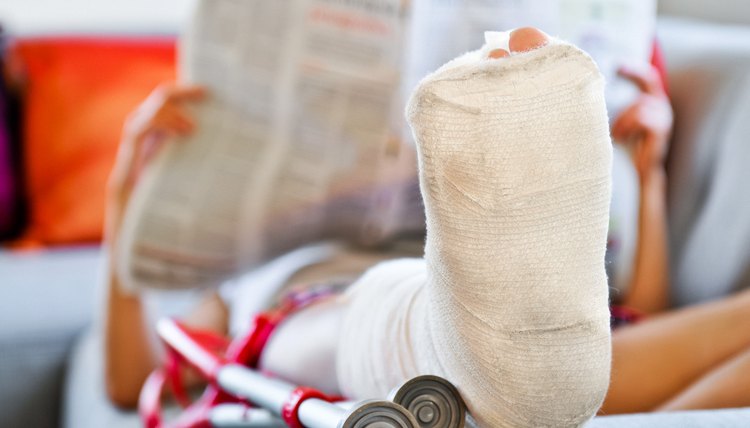If You Break Your Fibula, What Is Treatment Like?

Lower leg fractures can occur from trauma, falls, sports injuries or overuse. Fractures of the fibula bone — the smaller of the two bones of the lower leg — can be minor hairline cracks or severe enough to interfere with your ability to bear weight and walk. Treatment for a fibula fracture depends on the severity of the injury.
Tips
Fibula fractures are often treated with immobilization to allow the bone to heal.
Immobilization and Rest
Stress fractures of the fibula — microfractures caused by repetitive stress, rather than sudden force — are treated with immobilization and rest. These fractures are caused by repetitive activities, such as running.
Stress fracture typically affect the bottom of the fibula, the large prominence on the outside of the ankle. However, in rare cases, they can occur at the top of the bone near the knee, particularly with repetitive jumping activities.
Fibula stress fractures may be casted or splinted. Crutches are often used to reduce pain with walking for 1 to 2 weeks until you are able to bear full weight on your leg. Activities are generally resumed as pain decreases, under the specific guidance of your doctor.
Closed Reduction of Fibula Fracture
Closed reduction describes realignment of the ends of a broken bone without surgery. If the broken ends are close to their proper position, an orthopedic doctor uses her hands to realign the broken ends of your fibula bone to allow it to grow back together. A cast may be applied to keep the bones in place as they heal.
The fibula bone is not a weight-bearing bone, and your doctor may allow you to walk on the injured leg while it is healing. However, the fibula contributes to ankle stability, and you may have to use crutches to avoid putting weight on the leg until the ankle bones are healed.
Many factors affect this decision, including your activity level, doctor's preference and the severity of your injury.
Internal Fixation Surgery
A fibula fracture may require surgery, particularly if the bone pieces have moved far out of alignment or if the bone has broken into multiple pieces. Internal fixation refers to a surgical procedure used to realign and mechanically stabilize a severely broken bone.
A broken ankle may be stabilized with a screw or a plate and screws. K-wires — flexible metal wires — are also used to hold broken bones together to provide stability and allow them to heal.
Failure to Heal
In some cases, broken bones do not grow back together, a condition called nonunion. This can occur with the fibula bone, typically affecting the lower end of the bone where there is less soft tissue coverage and decreased blood supply.
Nonunion can be treated conservatively with electrical stimulation and magnetic devices, or it may require surgery. The area of bone that was fractured may be removed or surgically stabilized with a plate. Bone grafting may be required to fill the space where the bone has not healed.
References
- Canadian Journal of Surgery: Locked Plate Fixation of the Comminuted Distal Fibula: A Biomechanical Study
- International Orthopaedics: Nonunion of Fibula: A Systematic Review
- Archives of Orthopaedic and Trauma Surgery: Determinants of Outcome in Operatively and Non-Operatively Treated Weber-B Ankle Fractures
- Wheeless' Textbook of Orthopaedics: Weber B: Lateral Malleolus Frx
- Mayo Clinic: Stress Fractures
- American Medical Society for Sports Medicine: Proximal Fibula Stress Fracture in the Last Mile of a Marathon
- Mukherjee AN, Pal AK, Singharoy D, Baksi D, Nath C. Harvesting the free fibular graft: A modified approach. Indian J Orthop. 2011;45(1):53-6. doi:10.4103/0019-5413.73657
- Kortekangas T, Haapasalo H, Flinkkilä T, et al. Three week versus six week immobilisation for stable Weber B type ankle fractures: randomised, multicentre, non-inferiority clinical trial. BMJ. 2019;364:k5432. doi:10.1136/bmj.k5432
- Goost H, Wimmer MD, Barg A, Kabir K, Valderrabano V, Burger C. Fractures of the ankle joint: investigation and treatment options. Dtsch Arztebl Int. 2014;111(21):377-88. doi:10.3238/arztebl.2014.0377
- Gupton M, Kang M. Anatomy, Bony Pelvis and Lower Limb, Fibula. StatPearls Publishing. December 2018.
- Amaha K, Arimoto T, Saito M, Tasaki A, Tsuji S. Shorter recovery can be achieved from using walking boot after operative treatment of an ankle fracture. Asia Pac J Sports Med Arthrosc Rehabil Technol. 2017;7:10-14. doi:10.1016/j.asmart.2016.09.001
- Feigenbaum LA, Baraga M, Kaplan LD, et al. Return to Sport Following Surgery for a Complicated Tibia and Fibula Fracture in a Collegiate Women's Soccer Player with a Low Level of Kinesiophobia. Int J Sports Phys Ther. 2015;10(1):95-103.
- Harrast MA, Colonno D. Stress fractures in runners. Clin Sports Med. 2010;29(3):399-416. doi:10.1016/j.csm.2010.03.001
- Hsu H, Nallamothu S. Ankle Splinting. StatPearls Publishing. January 2019.
- Mehta SS, Rees K, Cutler L, Mangwani J. Understanding risks and complications in the management of ankle fractures. Indian J Orthop. 2014;48(5):445-52. doi:10.4103/0019-5413.139829
- Anderson RB, Hunt KJ, McCormick JJ. "Management of common sports-related injuries about the foot and ankle." J Am Acad Orthop Surg. 2010 Sep;18(9):546-56.
- Fields, KB. Fibular Fractures. In: UpToDate, Grayzel, J(Ed). 2017.
Writer Bio
Maureen Malone started writing in 2008. She writes articles for business promotion and informational articles on various websites. Malone has a Bachelor of Science in technical management with an emphasis in biology from DeVry University.
